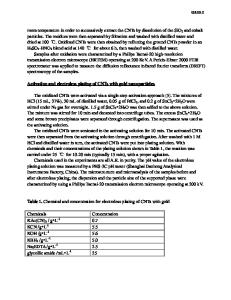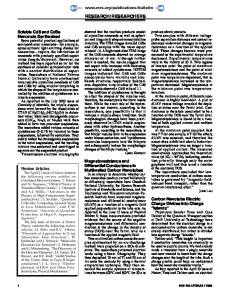Synthesis and Characterization of Multi-Walled Carbon Nanotubes with Semiconductor Nanoparticles for Optoelectronics
- PDF / 10,701,515 Bytes
- 6 Pages / 612 x 792 pts (letter) Page_size
- 22 Downloads / 278 Views
Synthesis and Characterization of Multi-Walled Carbon Nanotubes with Semiconductor Nanoparticles for Optoelectronics Marcos F. O. Silva*1, Wagner N. Rodrigues1, André S. Ferlauto1, Luiz O. Ladeira1, Carlos B. Pinheiro1 and Douglas R. Miquita2 1
Departamento de Física, ICEx, Universidade Federal de Minas Gerais, CP 702, 30123-970, Belo Horizonte, MG, Brazil 2 Centro de Microscopia, Universidade Federal de Minas Gerais, Av. Antonio Carlos 6627, 31270-901, Belo Horizonte, MG, Brazil * [email protected] ABSTRACT We demonstrate an easy way of decorating MWCNTs with CdS and CuxSy using the solvothermal method. INTRODUCTION Since carbon nanotubes (CNTs) first report in 1991 by Iijima [1], they have attracted the attention of scientists in many areas due to their extraordinary mechanical, chemical, and electronic features [2]. Their electrical transport efficiency grants them a huge potential for use in sensors [3], transistors [4] and other technological applications. Surface modification of CNTs with organic, inorganic or biological species may dramatically alter their electronic characteristics further broadening the potential use of such materials [5]. Semiconductor nanoparticles (NPs) have also attracted the interest of many researchers in recent decades, because of their unique size-tunable properties resulting from quantum confinement [6]. The control and development of new features according to the size of the particles is of great technological value. Within the great number of possible applications for this class of material we highlight optical sensors and other optoelectronic devices. The nanometer size of the NPs provides charge carriers with smaller paths, avoiding charge recombination inside the crystal and therefore potentially increasing the efficiency of the devices. Many authors have succeeded in decorating CNTs with semiconductor NPs, hence combining both qualities into a new composite. Shi et al. attached CdS NPs on multi-walled carbon nanotubes (MWCNTs) [7]; Ravindram et al. covalently coupled ZnS capped CdSe to acid treated MWCNTs [8]; and others have proposed methods to attach other semiconductors, such as TiO2 [9] and SnO2 [10] to CNTs. The CdS-CNT composite is of particular interest, since it was shown capable of generating photocurrent from visible light with unusual high efficiency [11]. Cadmium sulfide (CdS) is a well-known semiconductor, very stable, and easy to produce. It has a direct band gap of 2.4 eV at room temperature and for this reason it is used for lightemitting diodes, solar cells, and photo-resistors [12]. Copper sulfide is a rather complex material and harder to produce, which may be formed in many different structural phases, such as CuS, Cu2S, Cu1.8S, etc. Each of these phases has a distinct electronic behavior, including different band gap values that can be either direct or indirect. In spite of this complexity, there are many studies of and applications for this material in optoelectronics. In fact, during the 1950s and 1960s, the only all-thin-film solar cell available
was b
Data Loading...











